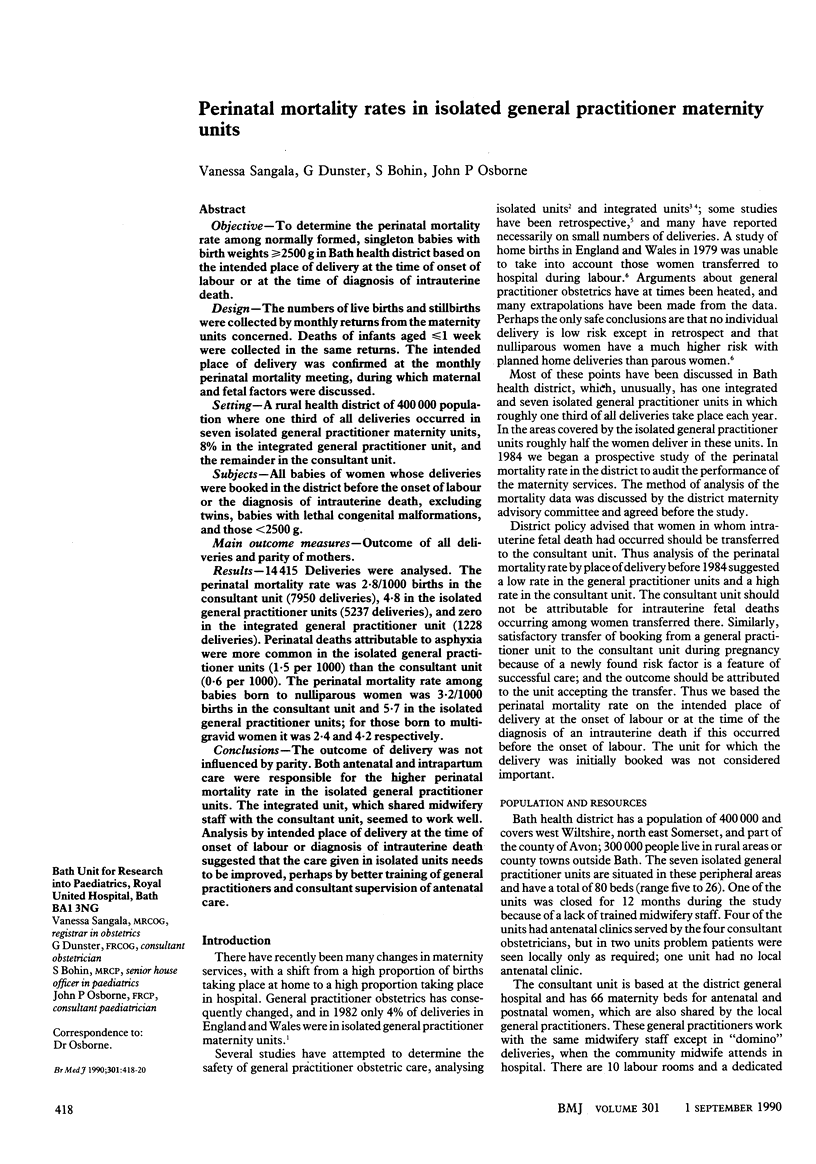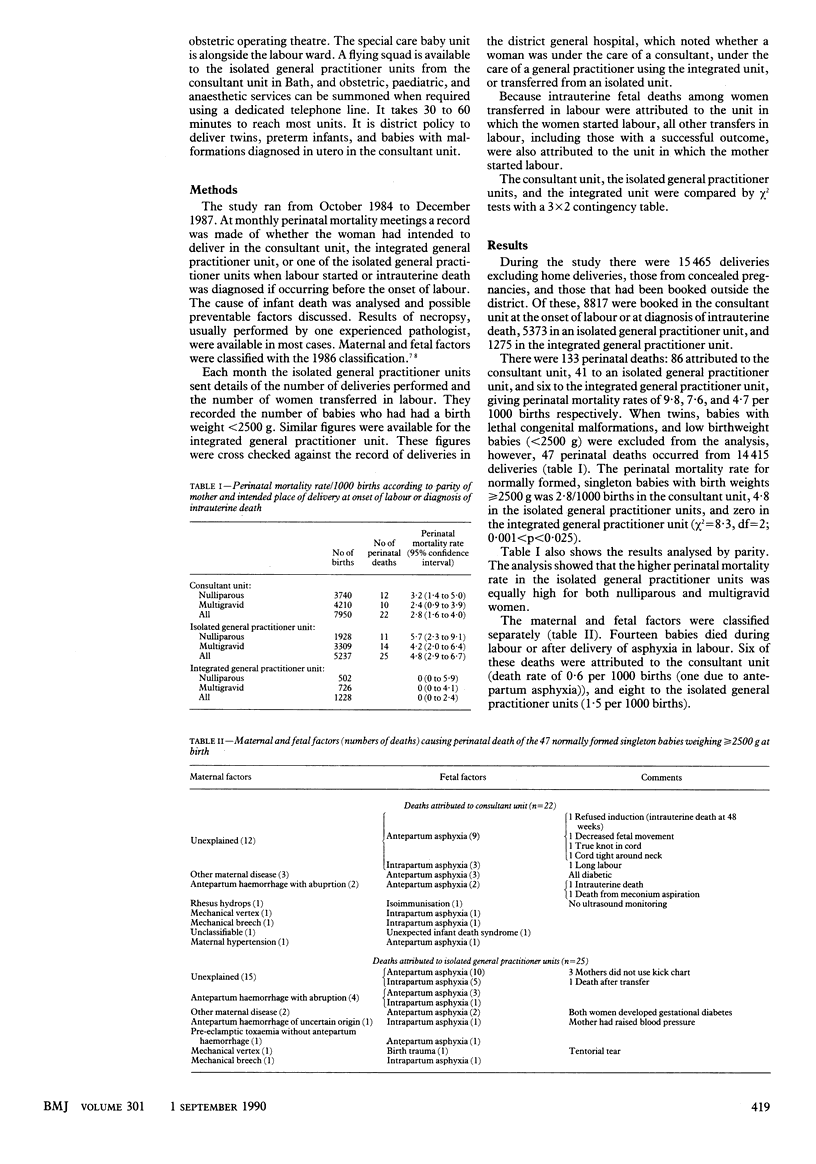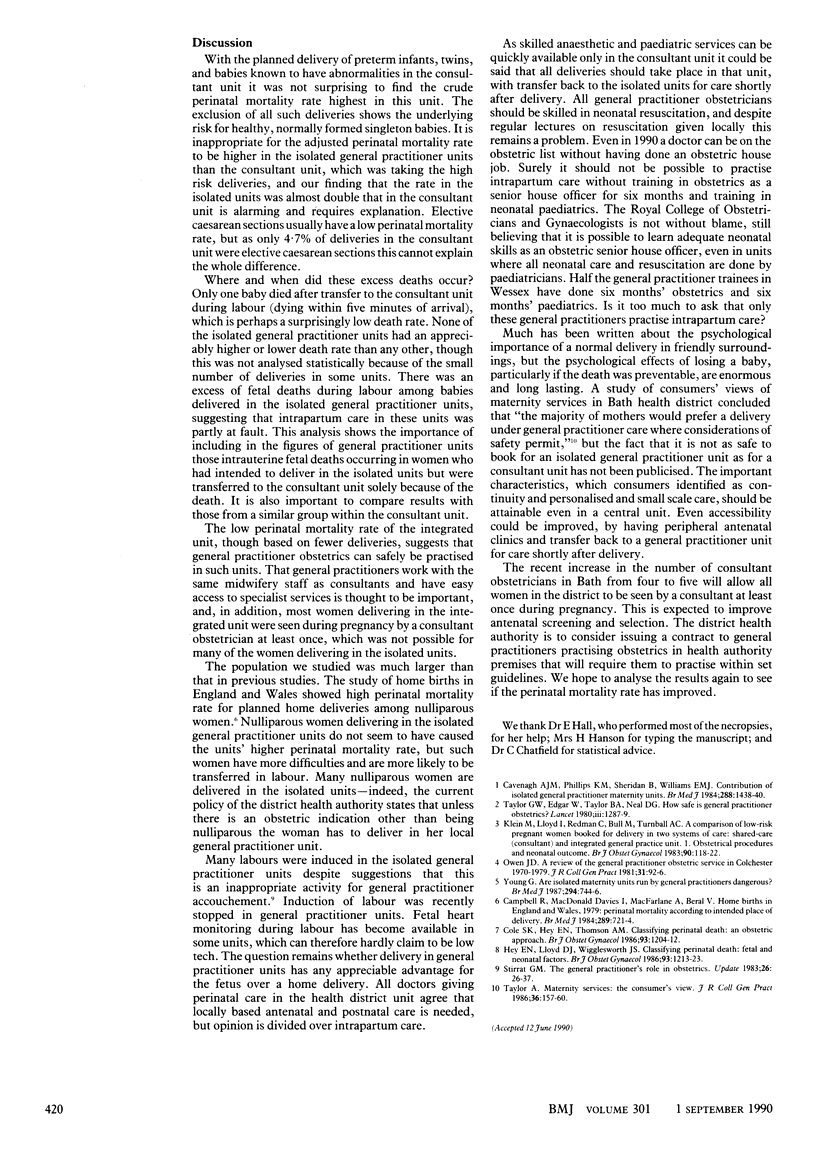Abstract
OBJECTIVE--To determine the perinatal mortality rate among normally formed, singleton babies with birth weights greater than or equal to 2500 g in Bath health district based on the intended place of delivery at the time of onset of labour or at the time of diagnosis of intrauterine death. DESIGN--The numbers of live births and stillbirths were collected monthly returns from the maternity units concerned. Deaths of infants aged less than or equal to 1 week were collected in the same returns. The intended place of delivery was confirmed at the monthly perinatal mortality meeting, during which maternal and fetal factors were discussed. SETTING--A rural health district of 400,000 population where one third of all deliveries occurred in seven isolated general practitioner maternity units, 8% in the integrated general practitioner unit, and the remainder in the consultant unit. SUBJECTS--All babies of women whose deliveries were booked in the district before the onset of labour or the diagnosis of intrauterine death, excluding twins, babies with lethal congenital malformations, and those less than 2500 g. MAIN OUTCOME MEASURES--Outcome of all deliveries and parity of mothers. RESULTS--14,415 Deliveries were analysed. The perinatal mortality rate was 2.8/1000 births in the consultant unit (7950 deliveries), 4.8 in the isolated general practitioner units (5237 deliveries), and zero in the integrated general practitioner unit (1228 deliveries). Perinatal deaths attributable to asphyxia were more common in the isolated general practitioner units (1.5 per 1000) than the consultant unit (0.6 per 1000). The perinatal mortality rate among babies born to nulliparous women was 3.2/1000 births in the consultant unit and 5.7 in the isolated general practitioner units; for those born to multigravid women it was 2.4 and 4.2 respectively. CONCLUSIONS--The outcome of delivery was not influenced by parity. Both antenatal and intrapartum care were responsible for the higher perinatal mortality rate in the isolated general practitioner units. The integrated unit, which shared midwifery staff with the consultant unit, seemed to work well. Analysis by intended place of delivery at the time of onset of labour or diagnosis of intrauterine death suggested that the care given in isolated units needs to be improved, perhaps by better training of general practitioners and consultant supervision of antenatal care.
Full text
PDF


Selected References
These references are in PubMed. This may not be the complete list of references from this article.
- Campbell R., Davies I. M., Macfarlane A., Beral V. Home births in England and Wales, 1979: perinatal mortality according to intended place of delivery. Br Med J (Clin Res Ed) 1984 Sep 22;289(6447):721–724. doi: 10.1136/bmj.289.6447.721. [DOI] [PMC free article] [PubMed] [Google Scholar]
- Cavenagh A. J., Phillips K. M., Sheridan B., Williams E. M. Contribution of isolated general practitioner maternity units. Br Med J (Clin Res Ed) 1984 May 12;288(6428):1438–1440. doi: 10.1136/bmj.288.6428.1438. [DOI] [PMC free article] [PubMed] [Google Scholar]
- Cole S. K., Hey E. N., Thomson A. M. Classifying perinatal death: an obstetric approach. Br J Obstet Gynaecol. 1986 Dec;93(12):1204–1212. doi: 10.1111/j.1471-0528.1986.tb07853.x. [DOI] [PubMed] [Google Scholar]
- Hey E. N., Lloyd D. J., Wigglesworth J. S. Classifying perinatal death: fetal and neonatal factors. Br J Obstet Gynaecol. 1986 Dec;93(12):1213–1223. doi: 10.1111/j.1471-0528.1986.tb07854.x. [DOI] [PubMed] [Google Scholar]
- Klein M., Lloyd I., Redman C., Bull M., Turnbull A. C. A comparison of low-risk pregnant women booked for delivery in two systems of care: shared-care (consultant) and integrated general practice unit. I. Obstetrical procedures and neonatal outcome. Br J Obstet Gynaecol. 1983 Feb;90(2):118–122. doi: 10.1111/j.1471-0528.1983.tb08894.x. [DOI] [PubMed] [Google Scholar]
- Taylor A. Maternity services: the consumer's view. J R Coll Gen Pract. 1986 Apr;36(285):157–160. [PMC free article] [PubMed] [Google Scholar]
- Taylor G. W., Edgar W., Taylor B. A., Neal D. G. How safe is general practitioner obstetrics? Lancet. 1980 Dec 13;2(8207):1287–1289. doi: 10.1016/s0140-6736(80)92348-x. [DOI] [PubMed] [Google Scholar]
- Young G. Are isolated maternity units run by general practitioners dangerous? Br Med J (Clin Res Ed) 1987 Mar 21;294(6574):744–746. doi: 10.1136/bmj.294.6574.744. [DOI] [PMC free article] [PubMed] [Google Scholar]


